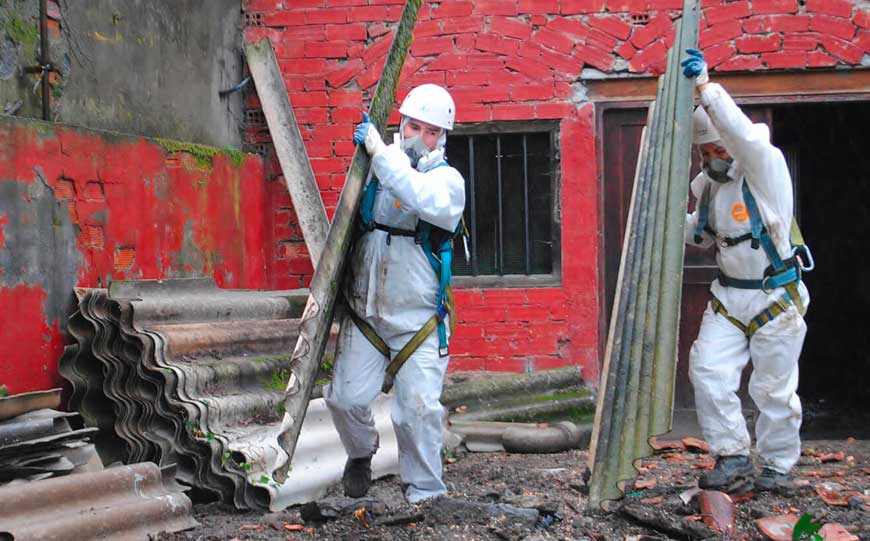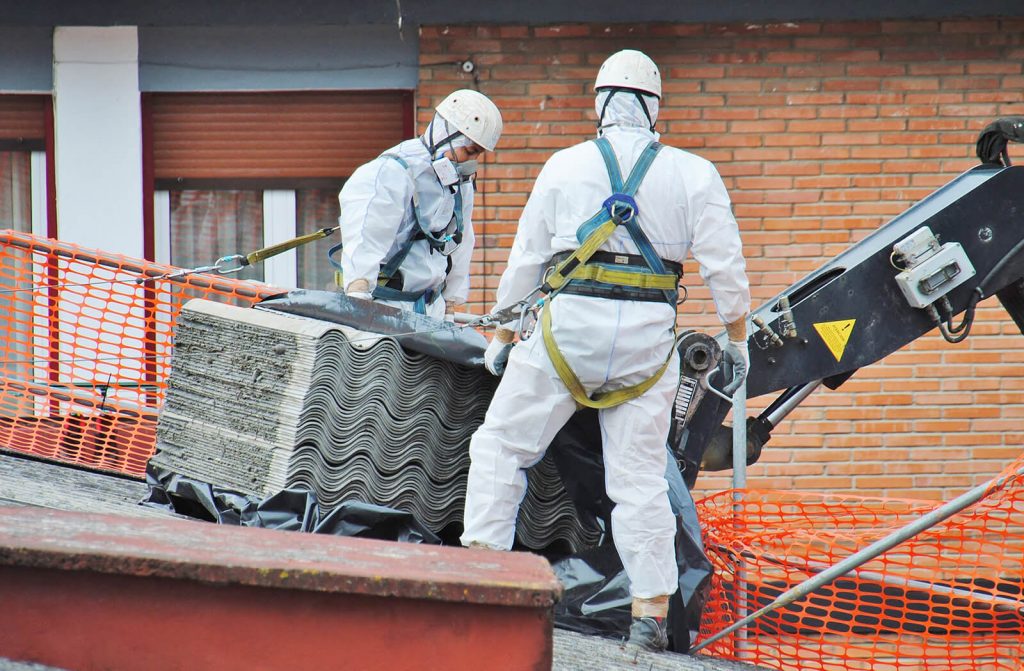
Once considered a remarkable and versatile material, asbestos has now revealed its sinister side – the grave health risks it poses.
The microscopic, airborne fibres released during asbestos removal can be extremely hazardous, causing severe illnesses such as mesothelioma and lung cancer.
In the face of these perilous hazards, the use of Personal Protective Equipment (PPE) becomes not just important but absolutely imperative.
This article is your key to understanding why PPE is the cornerstone of asbestos removal safety.
We will not only explain the significance of PPE but also navigate through the intricacies of selecting the finest masks, overalls, gloves, and footwear, all vital components in ensuring utmost safety.
Moreover, we will delve into the pivotal aspects of training, maintenance, and cleaning of asbestos PPE.
Table of Contents
Why is PPE Important for Asbestos Removal?
The importance of PPE in asbestos removal cannot be overstated.
To truly grasp its significance, it’s essential to understand asbestos exposure has huge health risks, and PPE plays a major role in mitigating these dangers.
Exposure to asbestos fibres has been linked to life-threatening conditions..
It can also lead to lung cancer, asbestosis (a scarring of the lung tissue), and other respiratory diseases.
The latency period between exposure and the onset of these diseases can be several decades, making asbestos exposure a long-term health risk.
This is where PPE for asbestos removal enters the picture as a paramount safeguard.
It serves as a robust and indispensable defence mechanism against the perils of asbestos exposure.
PPE creates a protective barrier, shielding workers from inhaling or coming into contact with asbestos fibres.
It is the last, and often most critical, line of defence for those labouring in environments contaminated with asbestos.
Without adequate PPE, individuals involved in asbestos removal are at grave risk, even if other safety measures, such as proper handling and containment, are meticulously followed.
Best Masks for Asbestos Removal

Choosing the right mask is absolutely critical when it comes to asbestos removal.
There are different types of respirators available, and selecting the one that matches the specific asbestos removal task and risk level is paramount for the safety of workers.
Disposable Masks (N95 or P100)
N95 masks are commonly used for low-risk asbestos removal tasks, such as minor repairs or maintenance where the asbestos-containing materials are in good condition.
They are designed to filter out airborne particles, including asbestos fibres, making them suitable for protecting against inhalation.
However, it’s crucial to note that disposable masks, while effective, do not provide a perfect seal around the face.
As a result, they are considered less suitable for high-risk asbestos removal activities where the concentration of asbestos fibres in the air may be significant.
Half-Face and Full-Face Respirators
For high-risk asbestos removal tasks, especially those involving substantial asbestos-containing materials or situations where the asbestos fibres may become highly concentrated in the air, half-face or full-face respirators are the preferred choice.
These respirators offer a much better seal around the face, significantly reducing the risk of asbestos fibre inhalation.
They not only protect the respiratory system but also provide essential eye protection, which is crucial in situations where there is a possibility of eye exposure to asbestos particles.
Full-face respirators, in particular, offer comprehensive coverage, ensuring both the respiratory and ocular safety of the wearer.
When selecting respirators for asbestos removal, it’s essential to ensure they meet the required safety standards.
Additionally, regular fit-testing of respirators is crucial to confirm that they provide an airtight seal and offer the expected level of protection.
Fit-testing should be conducted before initial use, whenever a new mask is selected, and periodically thereafter to ensure ongoing safety.
The choice between disposable masks and half-face or full-face respirators should be based on a thorough risk assessment of the asbestos removal task at hand.
High-risk situations, where asbestos exposure potential is significant, warrant the use of half-face or full-face respirators to maximise worker safety.
In any asbestos removal scenario, prioritising the selection and proper use of respirators is an absolute imperative to protect the health and well-being of those involved.
Best Overalls for Asbestos Removal

Selecting the right protective overalls for asbestos removal is crucial to ensure the safety of workers and prevent contamination.
Here are some key considerations and specific features to look for in the best overalls for asbestos removal:
Disposable Overalls
When it comes to asbestos removal, disposable overalls are the preferred choice. These overalls are designed to be used once and then discarded.
This disposability helps minimise the risk of asbestos fibres being carried home on work clothing, which could potentially pose health hazards to workers’ families.
Once the removal task is complete, the overalls should be carefully removed and disposed of as hazardous waste according to local regulations.
Coveralls with Hood and Boots
The most effective asbestos removal overalls come in a coverall style, which includes an attached hood and boots.
This design provides comprehensive full-body protection, ensuring that no skin is exposed to potential asbestos contamination.
The hood offers head and neck coverage, while the attached boots prevent fibres from reaching the feet and lower legs.
Microporous Material
Overalls for asbestos removal should be constructed from microporous material.
This type of fabric is breathable, allowing heat and moisture to escape, which is essential for the comfort of workers during extended tasks.
At the same time, the microporous structure acts as a barrier to block asbestos fibres from passing through.
This combination of breathability and protection is vital to maintaining worker comfort and safety.
Elastic Cuffs and Waist
Look for overalls with elastic cuffs at the wrists and ankles, as well as an elastic waist.
These features help create a secure, snug fit, minimising the risk of fibres entering the overalls through gaps.
A well-sealed fit is crucial for preventing asbestos exposure.
Zipper Closure
Overalls should have a zipper closure at the front, often covered by a protective flap that seals with adhesive strips.
This design ensures easy donning and doffing while maintaining a secure barrier against asbestos fibres.
The flap provides an extra layer of protection over the zipper area.
Sealed Seams
Check that the overalls have sealed seams.
Sealed seams are critical to preventing asbestos fibres from penetrating the fabric at vulnerable points.
High-quality overalls will have sealed seams throughout, ensuring complete coverage.
Size Selection
It’s important to choose the correct size of overalls to ensure a proper fit.
Overalls that are too loose may not provide adequate protection, while those that are too tight can restrict movement and compromise comfort.
Workers should be able to move freely and comfortably while wearing overalls.
Compliance with Standards
Always ensure that the chosen overalls meet relevant safety standards for asbestos removal.
These standards may vary by region, so check with local authorities or regulatory bodies for specific requirements.
Look for overalls that are certified for asbestos removal or hazardous material handling.
By prioritising the selection and use of appropriate overalls for asbestos removal, you can significantly reduce the risk of asbestos exposure and ensure the safety of workers involved in this critical task.
Best Gloves for Asbestos Removal
Selecting the right gloves for asbestos removal is a critical aspect of personal protective equipment (PPE) to ensure the safety of workers.
Here are some specific considerations and features to look for when choosing the best gloves for asbestos removal:
Disposable Nitrile or Latex Gloves
When it comes to asbestos removal, disposable gloves made from nitrile or latex are commonly recommended.
These materials strike a good balance between dexterity and protection.
They allow workers to maintain the necessary tactile sensitivity to perform tasks effectively while providing a barrier against asbestos fibres.
Nitrile gloves are particularly favoured for asbestos removal due to their excellent resistance to punctures and tears.
Asbestos-containing materials can be sharp or abrasive, and nitrile gloves offer robust protection against these hazards.
They also provide a reliable barrier against asbestos fibres.
Powder-free latex gloves are a suitable alternative, especially for individuals without latex allergies.
While latex gloves offer good protection and flexibility, it’s essential to ensure that all workers can safely use them without experiencing allergic reactions.
Disposable Design
Disposable gloves are essential for asbestos removal tasks.
They should be used once and then discarded as hazardous waste to prevent any potential contamination from being carried outside the work area.
Using disposable gloves for asbestos removal minimises the risk of asbestos fibres being spread to other locations, including workers’ homes.
Correct Sizing
Choosing the right glove size is essential to ensure a proper fit.
Gloves that are too tight can be uncomfortable and restrict hand movement, while those that are too loose may not provide adequate protection.
Workers should select gloves that fit snugly without being overly tight, allowing for comfortable and safe use.
By choosing the appropriate gloves and following established safety procedures, workers can effectively protect their hands from asbestos exposure during removal tasks.
Proper glove selection and usage are essential components of a comprehensive asbestos PPE strategy.
Best Footwear for Asbestos Removal
Selecting suitable footwear for asbestos removal is a critical aspect of PPE to ensure the safety of workers.
Here are some specific considerations and features to look for when choosing the best footwear for asbestos removal:
Disposable Boot Covers
Disposable boot covers are an essential component of asbestos PPE.
These covers are designed to be worn over regular work shoes to prevent asbestos contamination.
They create a barrier between the worker’s footwear and the potentially hazardous asbestos-containing materials.
Secure Fit
It’s essential to choose boot covers that provide a secure and snug fit.
Covers that are too loose can be ineffective, as they may not prevent asbestos fibres from entering the boot area.
Ensure that the chosen boot covers are available in various sizes to accommodate different footwear styles and sizes.
Resistant Material
The material used for disposable boot covers should be resistant to tears, punctures, and abrasions.
Asbestos-containing materials can have sharp edges or rough surfaces, which may damage boot covers made from less durable materials.
Look for boot covers made from strong and resilient materials to withstand the challenges of asbestos removal tasks.
Easy Application and Removal
Boot covers should be easy to put on and take off to encourage compliance among workers.
They should have user-friendly features, such as elastic closures or straps, to facilitate quick and secure attachment to regular shoes.
Does Asbestos PPE Require Training Before Use?

Absolutely, while PPE is a critical component of asbestos safety, it is just one piece of the puzzle.
Proper training is equally, if not more, important in ensuring the safety of individuals involved in asbestos removal.
Here, we will delve into the importance of training and certification in asbestos removal procedures, emphasising why they are essential for safeguarding the health of workers and the public.
Comprehensive Training
Training in asbestos removal is not a one-size-fits-all endeavour.
It should be comprehensive and tailored to the specific roles and responsibilities of those involved in asbestos abatement.
This includes workers and asbestos surveyors who handle asbestos-containing materials, supervisors who oversee removal projects, and individuals responsible for asbestos waste disposal.
Understanding Asbestos Risks
Training programs should provide a thorough understanding of the risks associated with asbestos exposure.
This includes knowledge about the health hazards posed by asbestos fibres, the different types of asbestos-containing materials, and the potential sources of exposure.
Workers must grasp the gravity of asbestos-related diseases and the long latency period between exposure and illness.
PPE Usage
Proper training covers the correct selection, usage, and maintenance of PPE.
This includes understanding the different types of respirators, gloves, coveralls, and footwear suitable for asbestos removal.
Workers should know how to inspect their PPE for defects, ensure a proper fit, and safely remove and dispose of contaminated gear.
Safe Work Practices
Training programs should instil safe work practices and procedures specific to asbestos removal.
This includes techniques for safely handling and removing asbestos-containing materials, minimising the release of asbestos fibres, and preventing contamination of work areas.
Workers should understand the importance of containment, negative air pressure, and controlled wetting to reduce asbestos exposure risks.
Decontamination
Proper decontamination procedures are a critical part of asbestos removal.
Training covers the steps involved in decontaminating workers, tools, equipment, and work areas.
This includes decontamination units, shower facilities, and waste disposal protocols.
Workers must learn how to decontaminate themselves and their gear effectively to prevent asbestos fibres from spreading.
Waste Disposal
Asbestos waste disposal is highly regulated due to its hazardous nature.
Training programs inform workers about the proper packaging, labelling, and transport of asbestos waste to approved disposal sites.
Understanding waste disposal regulations and compliance is crucial to prevent environmental contamination.
Ongoing Education
Asbestos removal procedures and regulations can evolve.
Therefore, ongoing education and training are essential to keep asbestos removal professionals up to date with the latest industry standards, best practices, and regulatory changes.
How to Clean & Maintain Asbestos PPE
The proper cleaning and maintenance of asbestos PPE is paramount to ensure its effectiveness and durability.
Here’s a closer look at the essential steps to maintain and clean asbestos PPE effectively:
Regular Inspection
Before each use, carefully examine all components of your PPE for signs of wear, damage, or deterioration.
Look for tears, holes, worn-out straps, or any defects that could compromise its integrity.
If you detect any issues during inspection, the affected PPE should be immediately discarded and replaced to prevent asbestos exposure.
Cleaning Procedures
After each use, it’s crucial to clean asbestos PPE thoroughly. The cleaning process typically involves the following steps:
- Refer to Manufacturer Instructions: Always consult the manufacturer’s guidelines for cleaning specific PPE items. These instructions are designed to ensure proper maintenance without compromising the materials.
- Gentle Cleaning: Asbestos PPE should be cleaned gently, using mild detergents or soaps. Avoid abrasive or harsh chemicals that may damage or degrade the materials.
- Wiping or Rinsing: Depending on the type of PPE, you may need to wipe it with a damp cloth or rinse it with water. Ensure that you clean all surfaces, straps, and any other components thoroughly. Pay extra attention to areas that might have come into direct contact with asbestos-containing materials.
- Drying: After cleaning, allow the PPE to dry thoroughly. Avoid exposing it to direct sunlight, extreme heat, or other conditions that might accelerate wear or damage. Proper ventilation is essential to prevent mould growth, especially in damp environments.
Storage Practices
How you store asbestos PPE can significantly impact its longevity and effectiveness. Here are some best practices for storage:
- Cool and Dry Location: Store PPE in a cool, dry area that is protected from direct sunlight and extreme temperatures. Excess heat can degrade materials, reducing their effectiveness.
- Protection from Contaminants: Ensure that stored PPE is shielded from potential contaminants or debris that could compromise its cleanliness and safety.
- Ventilation: Adequate ventilation is crucial to prevent mold growth, especially for items like coveralls that may retain moisture. Proper air circulation helps keep PPE in optimal condition.
Replacement
It’s vital to understand that asbestos PPE has a finite lifespan.
Replacing PPE items at the appropriate intervals, as recommended by the manufacturer, is essential.
Even if your PPE appears undamaged, age and regular use can impact its ability to provide adequate protection.
Follow the manufacturer’s guidelines or industry standards for PPE replacement to ensure the ongoing safety of asbestos removal workers.
Conclusion
The use of appropriate PPE during asbestos removal is not merely a recommendation; it’s a necessity to protect the health of workers.
Understanding the significance of masks, overalls, gloves, and footwear, as well as the need for training and proper maintenance, ensures that asbestos removal is performed safely.
By following these guidelines and investing in high-quality PPE, we can minimise the risks associated with asbestos exposure and work towards a safer, asbestos-free future.